For the best performance, get a manual turntable.
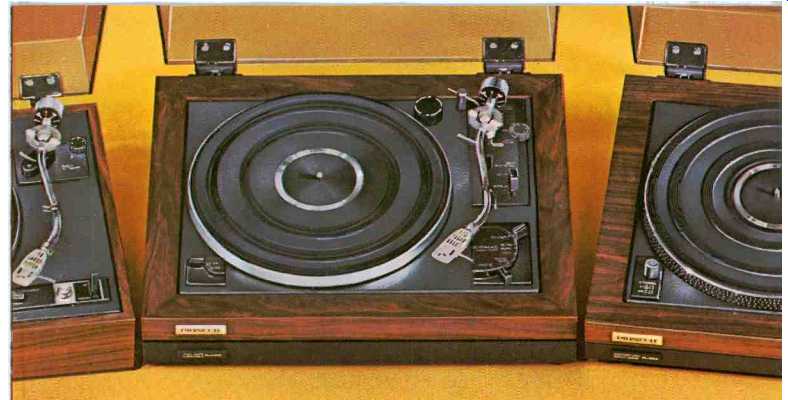

The manual turntable is rapidly becoming the first choice of hi-fi enthusiasts
everywhere. The reason why is quite simple. Today's enthusiasts are more knowledgeable,
more sophisticated and more involved with their music. And only the manual turntable
can provide the involvement and performance they demand.
At Pioneer, this trend comes as no surprise. We have long recognized the superiority of the manual turntable. And long recognized a simple fact: a record changer in no way improves performance. It can detract from it.
As a result, we now offer the finest and most complete line of manual turntables available. Manual turntables that are designed with the needs of today's hi-fi enthusiast in mind. Turntables that are engineered for precision response.
When you get right down to it, good record playing equipment really has only two requirements: uniform rotation of a turntable, and accurate tracing of a record groove by a tone arm and its cartridge.
Pioneer's engineers have long recognized that these requirements are best met by single-play turntables and precision engineered tonearms.
Our five new belt-drive and direct drive turntable systems mean you needn't settle for the higher wow and flutter and the poorer signal-to-noise ratios (rumble) of record changers.
Whether you've budgeted $100 or $300 for this vital element of your high fidelity system, there's a Pioneer turntable that outperforms any record changer in its price class.
Consider the performance advantages
Belt-drive, featured in Pioneer's PL-12D/II, PL-15D/II and PL-A45D, means smoother, more uniform platter rotation than can be achieved with typical idler-wheel/pulley arrangements normally found in record changers. Even changers equipped with synchronous motors transmit vibration to the turntable platter. This is picked up as low frequency rumble by the tonearm and cartridge. By driving the platter with a precision-finished belt, vibration is effectively absorbed before it can be translated to audible rumble.
-------
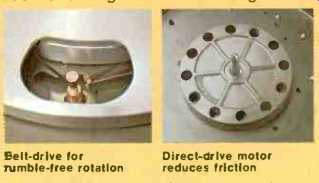
Belt-drive for rumble-free rotation; Direct-drive motor reduces friction
---------
Pioneer's direct-drive models, PL-55X and PL-71 go even a step further in achieving noise-free, precision platter rotation. The DC electronically controlled servo-motors used in these models rotate at exactly the required 33 1/3 and 45 rpm platter speeds. Their shafts are directly connected to the center of the turntable, with no intermediate pulleys or other speed reduction devices. This means no extra friction producing bearing surfaces.
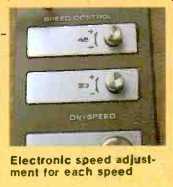
above: Electronic speed adjustment for each speed
Because of the unique technology embodied in these new, direct-drive motors, it's possible to control their speed electronically. This is more precise than any mechanical drive system. Both our PL-55X and PL-71 offer individual pitch control for both 33 1/3 and 45 rpm speeds. Their turntable platters are edge-fitted with stroboscopic marks, so you can adjust precise speed while a record is playing.
Both units are even equipped with a strobe light directed at the strobe marks for easy viewing.
Combine the best automatic features with manual operation
While many hi-fi enthusiasts demand completely manual turntable operation, there are many purists who prefer semi-automatic operation.
Pioneer provides this extra convenience in the PL-55X and PL-15D/II. Both models incorporate automatic tonearm return and shutoff. When the record has finished playing, the tonearm automatically returns to the arm rest and the power is turned off.
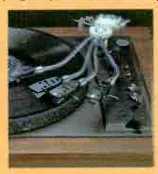
above: Automatic tonearm return and shutoff
The PL-A45D is completely automatic. You don't ever have to touch the tone arm when you play your records. This 2-motor model has a special precision
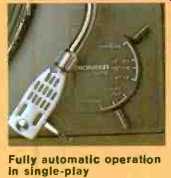
above: Fully automatic operation in single-play gear motor to exclusively
handle automatic tonearm lead-in, automatic return, automatic shutoff and repeat
play. And when you prefer, you can switch to fully manual operation.
The PL-71 and PL-12D/II, at both ends of Pioneer's turntable lineup, offer the total involvement that can only be attained by completely manual operation.
Superb S-shaped tonearms for better tracking
The tonearm of every Pioneer turntable system is the S-shape design, for optimum groove tracking. All are statically balanced and all use adjustable counterweights with direct reading of tracking force. All have adjustable anti skate control and oil-damped cueing for the gentlest application of stylus tip to record groove. Lightweight plug-in cartridge shells insure positive electrical contact and optimum stylus position and angle for lower distortion and reduced record wear.
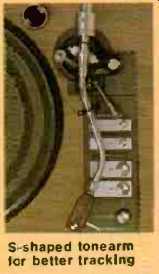
above: S-shaped tonearm tor better tracking
Unexcelled performance
Still, all of these features and refinements do not guarantee the performance specifications of Pioneer's new turntables. Each tonearm and turntable platter combination is shock mounted in its specially designed natural grain base (with hinged dust cover). Precision machining of all rotational parts plus continuous quality control insure that each will meet or exceed its published specifications-a time honored tradition with all Pioneer components.
Choice of the professionals Engineers, experts and enthusiasts agree: to get the best performance, select a manual turntable. And to get the best manual turntable, you need a Pioneer. Every Pioneer manual turntable offers a level of precision and performance unparalleled in its price range. And every one is a total system with dust cover and base designed for years of professional, trouble-free sound reproduction.
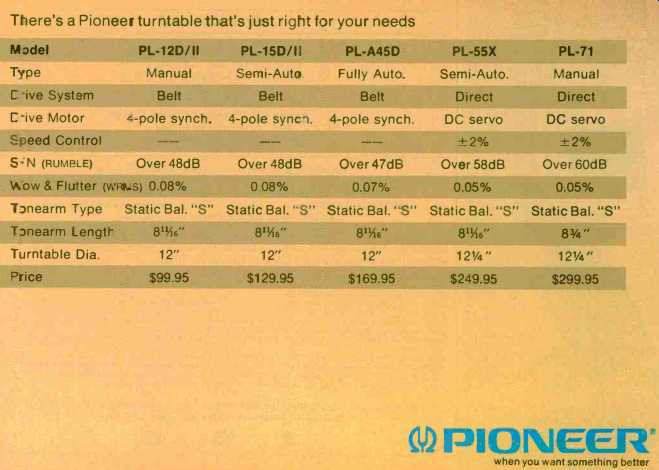
U.S. Pioneer Electronics Corp., 75 Oxford Drive, Moonachie, New Jersey 07074 / West: 13300 S. Estrella, Los Angeles 90248 / Midwest: 1500 Greenleaf, Elk Grove Village, Ill. 60007 / Canada: S. H. Parker Co.
( Audio magazine, June 1975)
Also see: Pioneer PL-510 turntable (May 1977)
= = = =